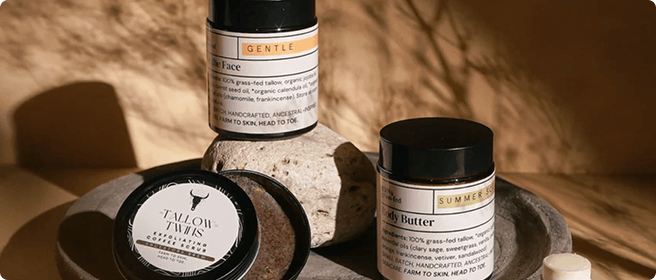Organ meats are having a quiet but undeniable comeback. From regenerative farmers to functional medicine practitioners, there’s a renewed fascination with the “nose-to-tail” philosophy (that we always preach)... the idea that the most nourishing, restorative parts of the animal are the ones we’ve forgotten how to eat.
For women, that shift is more than a foodie trend. Organ meats contain unique, highly bioavailable nutrients that directly support hormonal health, fertility, dewy skin, thick hair, and better energy. Yet for decades, they’ve been pushed to the margins of the modern plate. We grew up in an era where boneless, skinless chicken breasts were the gold standard of “healthy” eating, and anything that hinted of liver, heart, or kidney was deemed old-fashioned, strange, or unappealing (well, guess what - this is BS).
The irony is that in pushing these foods away, we’ve also pushed away some of the most potent, concentrated forms of nutrition available. Eating even small portions liver or heart can offer more vitamins and minerals than a week’s worth of salads and smoothies. The real challenge isn’t the science, it’s rediscovering the taste, the recipes, and the cultural connection that make these foods feel like a natural part of a modern woman’s diet.
Why Organ Meat is Having a Moment
Part of the renewed interest comes from the wellness world’s pivot toward ancestral eating. The more we learn about nutrient density, soil health, and the limitations of ultra-processed “health foods,” the clearer it becomes: our great-grandmothers were onto something. In a single portion, organ meats deliver magnitudes more vitamin A than carrots, far more iron than spinach, and B12 levels that rival the most expensive supplements on the market.
There’s also a growing awareness of sustainability. Eating nose-to-tail honours the whole animal and reduces waste (same with our tallow skincare), a value shared by regenerative agriculture advocates. And culturally, we’re starting to look beyond our borders, noticing that in countries like France, Mexico, and Japan, organ meats have never gone out of style...they’ve remained part of celebratory, everyday eating.
The Nutritional Powerhouse of Organ Meat
What makes organ meats extraordinary isn’t just their nutrient content, but the form those nutrients take. In liver, for example, vitamin A exists as retinol, the active form the body can use immediately, without conversion. This is crucial for women, as vitamin A plays a role in reproductive health, immune resilience, and skin regeneration. Liver also offers a rare combination of iron, B12, copper, and choline, all of which work synergistically to support energy production, collagen synthesis, and healthy brain function. AKA, makes you hotter and smarter.
Heart, often overlooked, is rich in CoQ10, a nutrient essential for mitochondrial energy production, a cellular-level boost that’s especially relevant for women managing stress, workouts, and hormonal fluctuations. Kidneys provide selenium, which supports thyroid health and immune balance, alongside a profile of B vitamins that help with metabolism and mood regulation. Even spleen, the most under-discussed of the group, offers an unmatched iron density, making it invaluable for women prone to anemia.
These aren’t trendy, niche nutrients; they’re the very building blocks our bodies need to function optimally. The difference is that in organ meats, they appear in a form and concentration no multivitamin can truly replicate.
The Female-Specific Benefits
For women, the benefits of organ meats align seamlessly with the most common wellness concerns. Take hormonal balance: minerals like zinc and vitamins like B6, abundant in heart and liver, play a direct role in progesterone production, which can ease PMS symptoms and support regular cycles. The healthy fats and cholesterol found in these cuts serve as the raw materials for estrogen and progesterone synthesis, something plant-based diets often struggle to supply in adequate amounts.
Fertility is another area where organ meats shine. Choline from liver and eggs supports fetal brain development and helps prevent neural tube defects. Iron and B12 safeguard against anemia, a common risk in pregnancy, while vitamin A promotes healthy reproductive tissue. These aren’t just abstract benefits; they translate into tangible changes in energy, mood, and resilience.
Then there’s beauty from the inside out. Retinol from liver fuels collagen production, keeping skin firm and luminous, while copper helps maintain healthy pigmentation in both skin and hair. Add in the amino acids needed for structural repair, and you have a recipe for radiance that starts in the kitchen, not at the cosmetics counter.
Even mental health gets a boost. B12 supports neurotransmitter production, which can lift mood and sharpen focus, while iron improves oxygen delivery to the brain, warding off fatigue and brain fog. Heart’s CoQ10 content further fuels mental and physical stamina, making these foods a genuine ally in navigating the demands of modern life.
Rewriting the “Ick” Factor
If the thought of eating liver or kidney makes you cringe, you’re not alone, but that hesitation is more cultural than instinctive. In France, pâté and foie gras are associated with elegance. In Mexico, lengua tacos are beloved street food. In China, pig liver soup is a postpartum staple for rebuilding strength and blood.
Western food culture shifted away from organ meats largely because of convenience-driven food processing in the mid-20th century. What was once common became an oddity, and eventually, a source of discomfort. The good news? Palates can adapt. So stop being a little baby and eat your organ meats hottie.
Approach them as you would a fine wine or artisan chocolate: something complex, worth appreciating, and deeply nourishing.
How Girls Eat Organ Meat in Real Life
The key to making organ meats a part of your diet is to start small and integrate them into familiar dishes. A modest amount of finely minced liver mixed into ground beef for burgers or meatballs delivers a nutrient upgrade without changing the flavour profile dramatically. A slice of pâté with warm sourdough and a sharp cornichon feels more like a Parisian café lunch than a “health food” compromise.
Cooking methods matter. Gentle heat preserves delicate nutrients and prevents the bitter notes that can emerge from overcooking. Pairing with bright, acidic ingredients like lemon or vinegar lightens the flavour, while fresh herbs (like rosemary or parsley) add freshness, babe!
Sourcing with Intention
Because organ meats concentrate both nutrients and potential toxins, quality matters. Look for grass-fed, pasture-raised animals from trusted farms, ideally those practicing regenerative agriculture. Farmers’ markets, reputable butchers, and online suppliers specializing in high-welfare meat are your best options.
Beyond personal health, sourcing well supports a food system that values the whole animal. Every time we choose organ meats, we help reduce waste, respect the animal, and contribute to a more sustainable way of eating.
Addressing Safety Concerns
Vitamin A toxicity is often raised as a concern with liver consumption, but the risk is minimal when eaten in moderation. The amounts that cause harm are typically associated with high-dose supplements, not a few ounces of food once or twice a week.
Cooking for safety doesn’t mean sacrificing nutrition. A light sear or gentle braise preserves both flavor and integrity. Proper storage (keeping organ meats refrigerated or frozen until use) ensures freshness and reduces bacterial risk.
From Tradition to Trend
Organ meats have always been part of women’s wellness traditions. In Traditional Chinese Medicine, liver is prescribed to replenish “blood” and energy. French women have long embraced pâtés as part of a balanced, beauty-supporting diet. Indigenous diets often reserved the most nutrient-rich cuts for women preparing for or recovering from childbirth.
Today, the pendulum is swinging back. Wellness leaders, chefs, and influencers are reframing these foods not as survival fare, but as gourmet nourishment. It’s a reminder that “trend” is often just tradition rediscovered.
A Return to Roots
Incorporating organ meats into your diet isn’t about following a fad, it’s about reclaiming a deeply human way of eating. These foods nourished generations before us and hold the key to solving many of the modern nutrient gaps women face today.
Start with a single recipe. Taste it without expectation. See how your energy, skin, and mood respond over time. Like any relationship with food, the benefits unfold when you give them space.
Pairing Inner and Outer Nourishment
We strongly believe that what you put on your skin should be as pure and nutrient-rich as what you put on your plate. Just as organ meats deliver bioavailable nourishment internally, our tallow-based skincare provides ancestral, skin-loving nutrition externally. Together, they create a holistic wellness ritual; one rooted in nature, tradition, and lasting vitality.
Shop ancestral, non-toxic skincare here.





